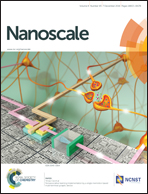Exploiting the interaction between a semiconductor nanosphere and a thin metal film for nanoscale plasmonic devices†
Abstract
The interaction of silicon (Si) nanospheres (NSs) with a thin metal film is investigated numerically and experimentally by characterizing their forward scattering properties. A sharp resonant mode and a zero-scattering dip are found to be introduced in the forward scattering spectrum of a Si NS by putting it on a 50-nm-thick gold film. It is revealed that the sharp resonant mode arises from a new magnetic dipole induced by the electric dipole and its mirror image while the zero-scattering dip originates from the destructive interference between the new magnetic dipole and the original one together with its mirror image. A significant enhancement in both electric and magnetic fields is achieved at the contact point between the Si NS and the metal film. More interestingly, the use of a thin silver film can lead to vivid scattering light with different color indices. It is demonstrated that a small change in the surrounding environment of Si NSs results in the broadening of the resonant mode and the disappearance of the zero-scattering dip. Our findings indicate that dielectric–metal hybrid systems composed of semiconductor NSs and thin metal films act as attractive platforms on which novel nanoscale plasmonic devices can be realized.


 Please wait while we load your content...
Please wait while we load your content...